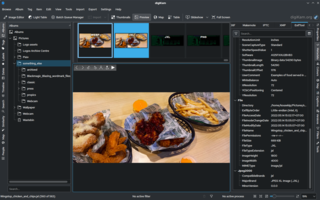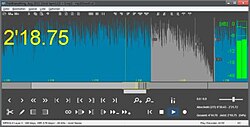A codec is a computer hardware or software component that encodes or decodes a data stream or signal. Codec is a portmanteau of coder/decoder.

In information technology, lossy compression or irreversible compression is the class of data compression methods that uses inexact approximations and partial data discarding to represent the content. These techniques are used to reduce data size for storing, handling, and transmitting content. Higher degrees of approximation create coarser images as more details are removed. This is opposed to lossless data compression which does not degrade the data. The amount of data reduction possible using lossy compression is much higher than using lossless techniques.

MP3 is a coding format for digital audio developed largely by the Fraunhofer Society in Germany under the lead of Karlheinz Brandenburg. It was designed to greatly reduce the amount of data required to represent audio, yet still sound like a faithful reproduction of the original uncompressed audio to most listeners; for example, compared to CD-quality digital audio, MP3 compression can commonly achieve a 75–95% reduction in size, depending on the bit rate. In popular usage, MP3 often refers to files of sound or music recordings stored in the MP3 file format (.mp3) on consumer electronic devices.
Windows Media Audio (WMA) is a series of audio codecs and their corresponding audio coding formats developed by Microsoft. It is a proprietary technology that forms part of the Windows Media framework. WMA consists of four distinct codecs. The original WMA codec, known simply as WMA, was conceived as a competitor to the popular MP3 and RealAudio codecs. WMA Pro, a newer and more advanced codec, supports multichannel and high-resolution audio. A lossless codec, WMA Lossless, compresses audio data without loss of audio fidelity. WMA Voice, targeted at voice content, applies compression using a range of low bit rates. Microsoft has also developed a digital container format called Advanced Systems Format to store audio encoded by WMA.
Advanced Audio Coding (AAC) is an audio coding standard for lossy digital audio compression. It was designed to be the successor of the MP3 format and generally achieves higher sound quality than MP3 at the same bit rate.
ID3 is a metadata container most often used in conjunction with the MP3 audio file format. It allows information such as the title, artist, album, track number, and other information about the file to be stored in the file itself.
The Apple Lossless Audio Codec, also known as Apple Lossless, or Apple Lossless Encoder (ALE), is an audio coding format, and its reference audio codec implementation, developed by Apple Inc. for lossless data compression of digital music. After initially keeping it proprietary from its inception in 2004, in late 2011 Apple made the codec available open source and royalty-free. Traditionally, Apple has referred to the codec as Apple Lossless, though more recently it has begun to use the abbreviated term ALAC when referring to the codec.
ReplayGain is a proposed technical standard published by David Robinson in 2001 to measure and normalize the perceived loudness of audio in computer audio formats such as MP3 and Ogg Vorbis. It allows media players to normalize loudness for individual tracks or albums. This avoids the common problem of having to manually adjust volume levels between tracks when playing audio files from albums that have been mastered at different loudness levels.
Gapless playback is the uninterrupted playback of consecutive audio tracks, such that relative time distances in the original audio source are preserved over track boundaries on playback. For this to be useful, other artifacts at track boundaries should not be severed either. Gapless playback is common with compact discs, gramophone records, or tapes, but is not always available with other formats that employ compressed digital audio. The absence of gapless playback is a source of annoyance to listeners of music where tracks are meant to segue into each other, such as some classical music, progressive rock, concept albums, electronic music, and live recordings with audience noise between tracks.
Flash Video is a container file format used to deliver digital video content over the Internet using Adobe Flash Player version 6 and newer. Flash Video content may also be embedded within SWF files. There are two different Flash Video file formats: FLV and F4V. The audio and video data within FLV files are encoded in the same way as SWF files. The F4V file format is based on the ISO base media file format, starting with Flash Player 9 update 3. Both formats are supported in Adobe Flash Player and developed by Adobe Systems. FLV was originally developed by Macromedia. In the early 2000s, Flash Video was the de facto standard for web-based streaming video. Users include Hulu, VEVO, Yahoo! Video, metacafe, Reuters.com, and many other news providers.

A tag editor is an app that can add, edit, or remove embedded metadata on multimedia file formats. Content creators, such as musicians, photographers, podcasters, and video producers, may need to properly label and manage their creations, adding such details as title, creator, date of creation, and copyright notice.
Media Foundation (MF) is a COM-based multimedia framework pipeline and infrastructure platform for digital media in Windows Vista, Windows 7, Windows 8, Windows 8.1, Windows 10, and Windows 11. It is the intended replacement for Microsoft DirectShow, Windows Media SDK, DirectX Media Objects (DMOs) and all other so-called "legacy" multimedia APIs such as Audio Compression Manager (ACM) and Video for Windows (VfW). The existing DirectShow technology is intended to be replaced by Media Foundation step-by-step, starting with a few features. For some time there will be a co-existence of Media Foundation and DirectShow. Media Foundation will not be available for previous Windows versions, including Windows XP.

MP3Gain is an audio normalization software tool. The tool is available on multiple platforms and is free software. It analyzes the MP3 and reversibly changes its volume. The volume can be adjusted for single files or as album where all files would have the same perceived loudness. It is an implementation of ReplayGain. In 2015 Debian and Ubuntu removed it from their repositories due to a lack of an active maintainer.
Mp3tag is a metadata tag editor that supports many popular audio file formats. It is freeware for Microsoft Windows, while it costs USD $24.99 for Apple macOS in the Mac App Store.

Simplified Universal Player Encoder & Recorder (SUPER) is a closed-source front end for open-source software video players and encoders provided by the FFmpeg, MEncoder, MPlayer, x264, ffmpeg2theora, musepack, Monkey's Audio, True Audio, WavPack, libavcodec, and the Theora/Vorbis RealProducer plugIn projects. It was first released in 2005. SUPER provides a graphical user interface to these back-end programs, which use a command-line interface.
In audio engineering, joint encoding is the joining of several channels of similar information during encoding in order to obtain higher quality, a smaller file size, or both.

Opus is a lossy audio coding format developed by the Xiph.Org Foundation and standardized by the Internet Engineering Task Force, designed to efficiently code speech and general audio in a single format, while remaining low-latency enough for real-time interactive communication and low-complexity enough for low-end embedded processors. Opus replaces both Vorbis and Speex for new applications, and several blind listening tests have ranked it higher-quality than any other standard audio format at any given bitrate until transparency is reached, including MP3, AAC, and HE-AAC.

AIMP is a freeware audio player for Windows and Android, originally developed by Russian developer Artem Izmaylov. It supports a variety of audio codecs, and includes tools to convert audio files and edit their metadata. It also has the capability of installing user-made skins and plugins. After its release, it has been well received by different parties.
HTML audio is a subject of the HTML specification, incorporating audio input, playback, and synthesis, as well as speech to text, all in the browser.

An audio coding format is a content representation format for storage or transmission of digital audio. Examples of audio coding formats include MP3, AAC, Vorbis, FLAC, and Opus. A specific software or hardware implementation capable of audio compression and decompression to/from a specific audio coding format is called an audio codec; an example of an audio codec is LAME, which is one of several different codecs which implements encoding and decoding audio in the MP3 audio coding format in software.








